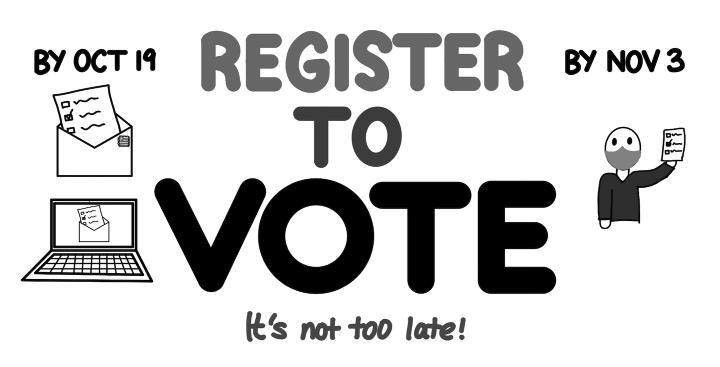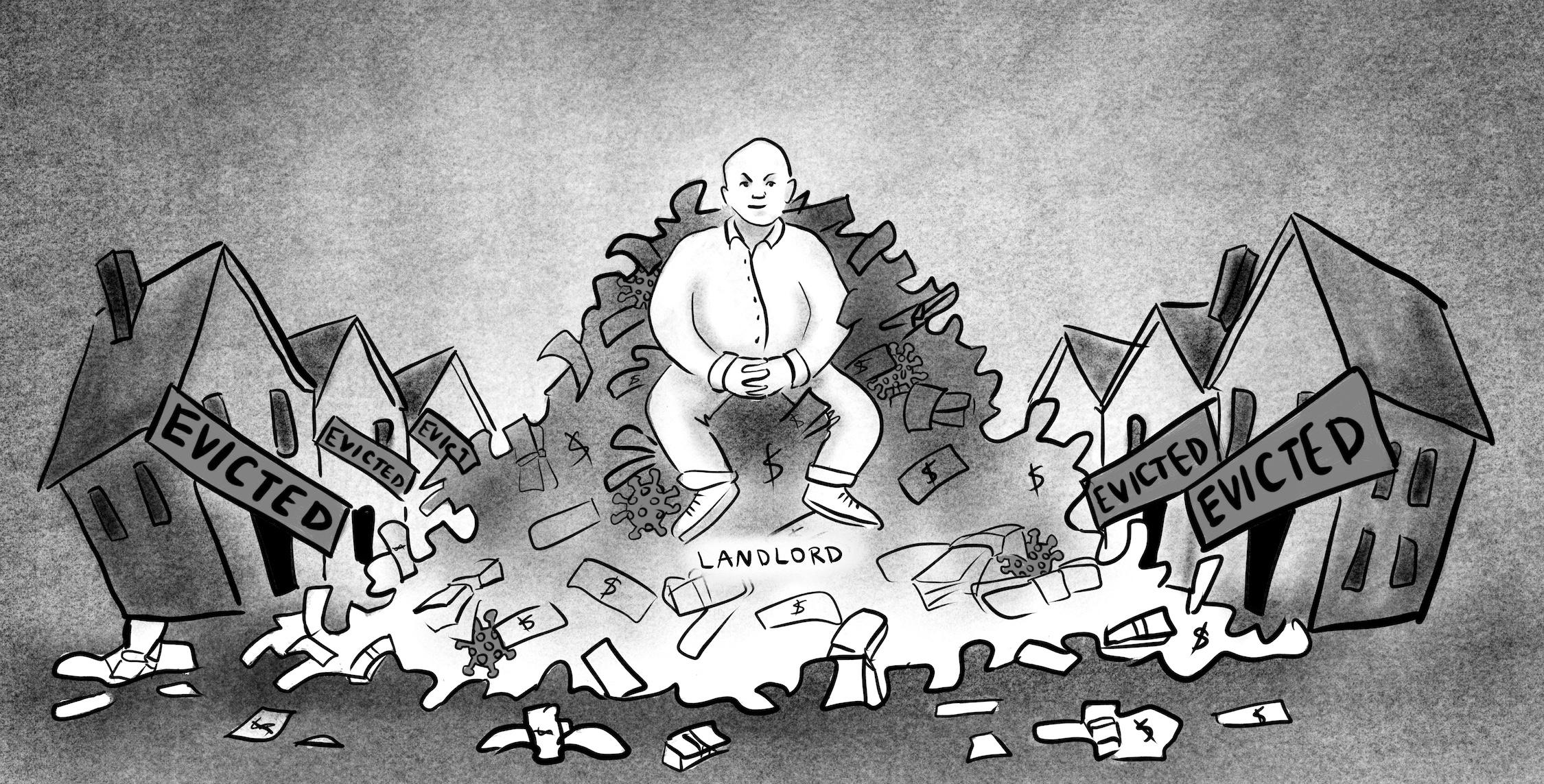Opinion
10 — Wednesday, October 14, 2020
JESSIE MITCHELL | COLUMN
A
Trolling is not a good use of federal funds
s institutions of higher learning begin to do the long-overdue work of examining structural racism within their communities, President Donald Trump’s administration is fighting hard to ensure it goes unacknowledged. On Sept. 2, Princeton University President Christopher Eisgruber wrote a statement to the Princeton community addressing systemic racism and acknowledging that “racist assumptions from the past also remain embedded in structures of the University itself.” The statement goes on to detail a number of new initiatives at Princeton that aim to create a more welcoming and diverse campus. In response, the Trump administration launched an investigation into Princeton’s compliance with the Civil Rights Act, which “prohibits discrimination on the basis of race, color or national origin in any program or activity that receives Federal funds or other Federal financial assistance.” In a letter to Eisgruber, the Department of Education argued that by admitting racism inherent to the institution, Princeton was also admitting that they discriminated based on race and were therefore in violation of the Civil Rights Act and ineligible for federal funding. Princeton stood by the original
statement, as they should have. Grappling with a fraught history, and attempting some remedy, is something that all institutions should strive to do. One of the examples that President Eisgruber cites, the nine departments centered around European language and culture departments at Princeton versus one centered around African studies, is a discrepancy that can be found at other universities across America. The reaction by the Department of Education to Princeton was unique. Plenty of other universities have admitted to systemic racism at their schools, including flagship institutions like the University of Michigan and the University of Virginia, without the threat of legal action by the Trump administration. So then, why Princeton? Likely, the timing of the statement by Princeton fits in with Trump’s ill-advised strategy of pretending that racism no longer exists. It’s an odd position to take, given that more than three-quarters of Americans agree that racism and discrimination are “a big problem,” as stated in a Monmouth University poll released in early June. By equating an admission of systemic racism to a violation of the Civil Rights Act, the Trump administration’s official position seems to be that the Civil Rights Act solved racism, and if it didn’t,
that’s a personal problem. Most Americans don’t seem to agree with that anymore. There were plenty of conservative commenters who reacted with glee at the administration’s announcement that they were going to investigate Princeton. Right-wing pundit Ben Shapiro tweeted an article about the news, saying “This is absolutely spectacular,” but reactions seemed less focused on whether this was a smart policy move on the part of the Department of Education and more on mocking people with the gall to admit that racism exists. Two recent Princeton graduates wrote, in support of the Department of Education’s investigation, that “the DoE had no choice but to act on the investigative trolling opportunity of a lifetime.” To insist that the administration’s best use of time and resources is to investigate Princeton for civil rights violations that authors do not believe exist solely to “troll” shows flagrant disregard for actual civil rights violations. The Civil Rights Act is not a joke and the Trump administration should not use it to attack universities attempting to pursue racial equity. To applaud the degradation of the Civil Rights Act in service of a “gotcha” moment is disgusting. It is also hard to see the end
game with this move. If Princeton is found to be in violation of the Civil Rights Act due to systemic racism, it would follow that the Princeton education — that of a handful of legislators and Supreme Court Justices — is also racist. This would strengthen the claim that racism is institutionalized in America, not weaken it. Of course, the Trump administration is banking on Princeton bending over backward to avoid losing their federal funding, which, according to The Atlantic writer Conor Friedersdorf, would “expos(e) racism claims … as hyperbole.” In other words, the Trump administration is planning on wasting resources to prank Princeton. A statement by Princeton’s president does not make systemic racism any more or less real. It does not solve the problem outlined by more than 300 of Princeton’s faculty members. But, it’s an imperfect step in the right direction. To expect the president’s administration to avoid treating these messy moments of reckoning as a chance to “troll” at the expense of American taxpayers feels like something we should be able to take for granted, but in Trump’s America, racism was solved in 1964. Jessie Mitchell can be reached at jessiemi@umich.edu.
CHRISTINA KIM | CONTACT CARTOONIST AT CKIMC@UMICH.EDU
The Michigan Daily — michigandaily.com
EVAN DEMPSEY | COLUMN
Healthy Streets need more feet
S
tudents returning to campus this fall may have noticed a new profusion of orange traffic barrels around Ann Arbor. Though they have nothing to do with road maintenance, the barrels can be seen along the sides of several of the city’s busiest thoroughfares, blocking vehicles from entering the outermost lanes. Judging by the general lack of cyclists and pedestrians using these lanes, however, it seems that many people have not investigated exactly what they are for. The new car-free lanes are part of a City of Ann Arbor initiative called the Healthy Streets Program, which was launched on May 4, 2020, in an attempt to promote social distancing among people who would otherwise have been confined to city sidewalks. The program has reconfigured traffic on over 30 streets in Ann Arbor. Of particular note are the eight high-traffic streets (including Main, State and Packard streets) that have had entire lanes sectioned off for pedestrian traffic. These reconfigured lanes have been converted into twoway “streets” for cyclists and pedestrians, essentially as an extension of existing sidewalks. As a frequent runner and biker, I have found this new abundance of walkable, bikeable roadway to be very useful, and although it seems to be underutilized now, I believe there are plenty of ways in which the Ann Arbor community could benefit from making better use of the Healthy Streets Program. Not only is it easier to maintain proper social distancing while walking or running along busy streets (which, in Ann Arbor, is very difficult to avoid doing), the new lanes allow me to run through normally crowded areas like downtown without being a nuisance to other pedestrians — something that was hard to do even prepandemic. I’ve also found Healthy Streets to be a vast improvement in terms of “bikeability.” Standard bicycle lanes are often very narrow and leave cyclists with no barrier against automobile traffic. The lanes reconfigured by Healthy Streets, however, are essentially mini-streets. With two lanes, there is much more space for cyclists to maneuver, and the barrels act as a deterrent to cars that might stray too close. In my experience, this
has made for much safer and more enjoyable biking trips. As much as I have made use of the Healthy Streets Program so far, I have been routinely surprised at how few other people I encounter using the converted lanes. Despite having run or biked on a reconfigured street several times a week since the start of the semester, I can still count with my fingers the number of other people I’ve passed. My estimate of how many people are using Healthy Streets is based on purely anecdotal evidence, and understandably, people are traveling fewer places right now. Nonetheless, I feel that an exhortation to the people of Ann Arbor to take advantage of this program is in order: According to the City of nn Arbor website, the program is only in effect until Nov. 10, and whether or not these changes are permanent depends on you. Staff members from the city and the Ann Arbor Downtown Development Authority have been monitoring the Healthy Streets since their launch in order to determine their effectiveness. One of the criteria used to determine whether any reconfigurations will become permanent is the volume of people using the converted lanes. Even if you don’t have anywhere to go right now, I strongly suggest that you go for a walk (or bike or run) on a Healthy Street. You might find that the new road configuration improves your experience of downtown and other areas, as it did mine. If nothing else, you’ll be helping to make our city healthier and safer by driving a transition to car-free, people-focused roadways. In fact, Healthy Streets operates alongside the People Friendly Streets program, a more long-term Ann Arbor initiative launched in order to redesign roadways to promote carbon neutrality, economic development and personal safety. The Healthy Streets Program was created to address an immediate problem: the COVID19 pandemic. But if we provide the program with enough support, it will provide benefits much farther into the future than the pandemic will last and make our community improvements much more permanent than just a few orange barrels. Evan Dempsey can be reached at evangd@umich.edu.
EVAN STERN | COLUMN
N
Whitmer’s powers should be checked, even in the middle of a pandemic
early seven months after Gov. Gretchen Whitmer issued her first executive order aimed at battling the COVID19 pandemic in March, the Michigan Supreme Court ruled on Oct. 2 that Whitmer “had no authority to issue or renew executive orders relating to Covid-19 beyond April 30,” according to CNN. The 4-3 ruling, which Whitmer said in a statement she “vehemently disagrees” with, effectively strips away all of the governor’s powers to unilaterally issue executive orders aimed at containing COVID-19. The court, however, notes that the decision “leaves open many avenues for the Governor and Legislature to work together to address this challenge.” Since the first cases of COVID19 were confirmed in Michigan on March 10 — one in Oakland County and another in Wayne County — Whitmer has worked under a state of emergency and issued a wide variety of executive orders to curb the impacts of the pandemic. However, some argued that she had no authority to continue issuing orders without the consent of the Michigan State Legislature after April 30, the date her initial emergency declaration expired. Until the court struck down Whitmer’s emergency powers, the governor relied on two laws, one from 1945 and the other from 1976, to issue executive orders unilaterally. Now, under the Michigan Supreme Court’s recent decision, Whitmer can invoke neither law to extend a state of emergency or issue further orders without working with the legislature. The Michigan Supreme Court’s ruling delivers a major blow to the emergency powers Whitmer has wielded in order to control the spread of COVID-19 across the state. The governor stated that, “Right now, every state and the federal government have some form of declared emergency. With this decision, Michigan will become the sole outlier at a time when the Upper Peninsula is experiencing rates of COVID-19 infection not seen
in our state since April.” While some fear that the decision will lead to an uptick in cases across the state as the governor loses her authority, others — including State Senate Majority Leader Mike Shirkey, R-Clarklake — celebrated the ruling. On the whole, Whitmer has expertlynavigatedtheunprecedented crisis, and her decisive actions deserve praise. Although the governor’s orders have been met with criticism, a poll released in May found that nearly 64% of Michiganders approve of Whitmer’s handling of the crisis. But at the same time, many people have expressed great concern about the governor’s far-reaching powers to single-handedly issue executive orders that impact the entire state population of 10 million people. While Whitmer has acted with the best interests of Michiganders in mind, it is not prudent by any stretch of the imagination to allow one person, regardless of the circumstances, to hold so much power. Ultimately, while the people of Michigan elected Whitmer as governor in 2018, she heads one of three branches that govern our state. Even though we continue to find ourselves in the middle of a dangerous public health crisis, Michiganders didn’t just elect Whitmer; they also elected representatives to the State House of Representatives and State Senate, who have been largely excluded from exercising their power and collaborating with Whitmer on executive orders. Regardless of the circumstances — no matter how dire the emergency is — we cannot allow one leader to unilaterally make sweeping executive orders. It is the responsibility of the governor to work with the representatives of the state legislature to protect the health of our state. Meanwhile, it is the responsibility of Michigan’s elected representatives to put checks and limits on Whitmer’s powers as they deem necessary. It doesn’t matter what kind of crisis our state is confronting, and it doesn’t matter whether the people of
Michigan have elected a Republican, Democrat or Independent; ultimately, it is dangerous to disproportionately allocate any amount of power to a single branch of government. Throughout the course of Whitmer’s free rein, the people of Michigan learned firsthand the perils of vesting so much political power in the office of the governor. Although most of Whitmer’s actions were justifiable and protected Michiganders from contracting COVID-19, there were undoubtedly a handful that needed improvement. However, with Michigan’s legislators being shut out of the process, our governor had total discretion to issue arbitrary executive actions, even if they had significant costs; nobody had the political means to influence her executive orders and strike down certain aspects that were problematic. For instance, Whitmer got flak nationwide for her order barring the sale of certain products in retail stores like seeds, home gardening supplies and paint. As the Detroit Free Press noted, this order strangely permitted purchases of lottery tickets in stores at the same time, which the state uses to fund certain programs. Beyond ordering stores to block off certain sections that sold goods deemed “non-essential,” Whitmer kept Michiganders under one of the longest-running stay-at-home orders in the nation, even amid the obvious economic carnage of such moves that our state is still reeling from today. In Oakland County alone, the state’s second-largest county, the University of Michigan Research Seminar in Quantitative Economics found that a quarter of small businesses were lost, along with nearly 160,000 jobs. Finally, even throughout the summer months, as Michigan experienced low numbers of new cases as well as a small test-positivity rate, Whitmer prohibited businesses like gyms and movie theaters from reopening. As a result,
many business owners who have invested their whole lives in these industries have teetered on the edge of collapse for reasons with little support from a public health standpoint. Right here in the heart of Ann Arbor, according to the Daily, the Michigan Theater and State Theater recorded financial losses of $1.5 million, forced to keep their doors closed well into the fall as other businesses across the state like hair salons opened in June. Another theater owner in the state, according to the Holland Sentinel, said “revenue has been down about 95 percent since the coronavirus pandemic shutdown began in midMarch.” These losses are staggering and could have been averted if Whitmer couldn’t unilaterally keep the economy closed. If the Michigan State House and Senate had a say, we could have combated the pandemic just as successfully while also supporting the hardworking people of Michigan. In the Design courtesy of Katherine Lee
midst of this deadly pandemic, it is inconceivable why we suddenly abandoned our American principles of checks and balances and opted to allow one leader to navigate this viral storm. In Michigan — along with our federal government in Washington, D.C. — we all know our government is based on checks and balances and the separation of powers. These checks on emergency powers don’t become irrelevant in the middle of a public health crisis like the COVID-19 pandemic, as some have argued; on the contrary, they are more important in order to prevent abuses of power. On the international stage, experts have argued that the exponential spread COVID-19 opens the door for world leaders to “tighten their grip on power.” There is no evidence Whitmer has abused her powers. She has handled the crisis with one goal: to protect the state of Michigan. However, it is exceedingly evident
that her steady refusal (until now) to work with our legislators has cost our state. In the wise words of Montesquieu, as the Michigan Supreme Court noted in its decision, “When the legislative and executive powers are united in the same person...there can be no liberty.” As the pandemic continues to rage on, accelerating as the weather cools down and we approach the end of the calendar year, we need to rethink our approach to mitigating this crisis here in Michigan, and ensure that all branches of government have a say in the next steps forward. I applaud Michigan’s high court for taking this action, and I look forward to Gov. Whitmer, our elected state representatives and other government bodies working collectively to protect our state. Evan Stern can be reached at erstern@umich.edu.





